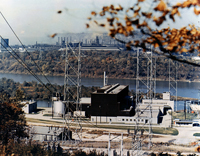Nuclear Energy
Brief History of Nuclear Energy
Compared to other energy sources which have been used for centuries, nuclear energy is much newer.
| Scientific Discoveries | Nuclear for Weaponry | Nuclear for Electricity |
 |
 |
 |
| In 1938, two German scientists bombarded an atom’s nucleus with a neutron and split the atom. Shortly thereafter, a Hungarian scientist discovered that the process of splitting the atom, or fission, could generate lots of energy via a chain reaction in which the extra neutrons given off by each fission reaction strike other uranium atoms to cause them to split and continue to react. | During World War II, the United States, Britain and Canada used fission to develop nuclear weapons for the war. The codename for this work was the Manhattan Project. It yielded the world’s first nuclear bombs which were used at Hiroshima and Nagasaki. After the war ended, scientists began investigating peaceful uses of nuclear energy. | In 1954, the Obninsk Nuclear Power Plant opened in the USSR. It was the world’s first nuclear power plant. It could produce about 5 megawatts of electricity which is supplies to the utility grid. In 1957, the Shippingport Atomic Power Station (pictured above) opened in the USA. It was the first US commercial reactor. |
During the last third of the 20th century, a general movement against nuclear power has risen based on the fear of a possible nuclear accident as well as the history of accidents at Three-Mile Island in Pennsylvania and at Chernobyl in the Soviet Union (now Ukraine). However, with the Obama administration, there is now renewed interest in nuclear energy.

